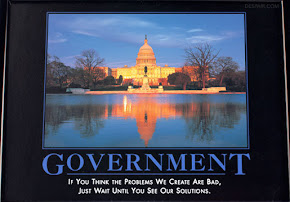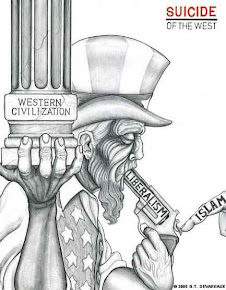Friday, June 11, 2010
New Poverty Measure Doesn’t Add Up
Someone once said that you could prove almost anything by using statistics. We have seen it in the recent ClimateGate scandals, and now we see it in the sliding scale used to determine how many Americans live in poverty. By excluding Government assistance and using a sliding scale, (if those above the poverty level improve their economic standing, then the poverty level baseline raises also), then the number of those living within the new poverty levels will rise. By not including Government welfare and food stamp payments to the income numbers, these recipients are still considered to be in poverty.
Another factor increasing the number living in poverty is, surprise, surprise, our porous border to the South. Illegal immigrants are a major cause of the increase.
Excerpt: the new calculation would measure poverty on a sliding scale. Thus, if the average income of families in the United States’ increases so too does the poverty threshold. Talk about keeping up with the Jones. This new measure provides the perfect climate for left-leaning politicians to promote equalization of wealth through redistribution. This new measure would bump poverty up 30 percent: more poverty equals more political fodder to argue for increased welfare.
Unfortunately, the method currently used to calculate the poverty rate is already skewed, creating a “crisis” of poverty in the United States. This is because only a family’s pre-tax income is included in total income when determining their poverty level. Thus, despite the fact that the average poor household receives $28,000 dollars in welfare benefits annually, these benefits are not included in their income. Not surprisingly then, even though the United States has increased welfare spending by 13 fold (adjusting for inflation) since the war on poverty began in 1965, the poverty rate has stayed much the same.
However, the standard of living for the poor has increased substantially. Today, 43 percent of the poor own their own homes (80 percent have air conditioning and only 6 percent say they are overcrowded), approximately 75 percent own a car, 97 percent own a television, and nearly 80 percent have a VCR or DVD player. This definition of poverty, as Samuelson notes, referencing the late Daniel Patrick Moynihan, is scaled up. On the other hand, only about two percent of Americans report that they often do not have enough food to eat.
Another reason for the ever-consistent poverty level, one that the Left does not like to address, is the increase in low-skill immigrants. According to Samuelson:
“From 1989 to 2007, about three-quarters of the increase in the poverty population occurred among Hispanics — mostly immigrants, their children and grandchildren….Poverty ‘experts’ don’t dwell on immigration, because it implies that more restrictive policies might reduce U.S. poverty.”
The cost of low-skill immigration to the United States is significant. Research by Heritage’s Robert Rector indicates that for every $1 that a low-skill immigrant contributes in taxes, he or she receives $3 in benefits.
If the Obama administration is genuinely interested in reducing poverty, they should start by aiming at its root causes: low work rates and single motherhood. The welfare reforms of 1996 increased work among the poor and reduced child poverty, and Bush’s Healthy Marriage Initiative provided funding to promote marriage education for low-income individuals. The current administration has sought measures that deliver deathblows to both policies. Furthermore, it would be wise to promote measures that discourage illegal immigration, such as securing the borders and enforcing employment laws, among others.
Rather than illuminating the problem of poverty, this faulty poverty measure will only obscure the most relevant facts. The result will be more government spending that we as a nation cannot afford and that does little help those in need. Read The Foundry article "New Poverty Measure Doesn’t Add Up" here.
Another factor increasing the number living in poverty is, surprise, surprise, our porous border to the South. Illegal immigrants are a major cause of the increase.
Excerpt: the new calculation would measure poverty on a sliding scale. Thus, if the average income of families in the United States’ increases so too does the poverty threshold. Talk about keeping up with the Jones. This new measure provides the perfect climate for left-leaning politicians to promote equalization of wealth through redistribution. This new measure would bump poverty up 30 percent: more poverty equals more political fodder to argue for increased welfare.
Unfortunately, the method currently used to calculate the poverty rate is already skewed, creating a “crisis” of poverty in the United States. This is because only a family’s pre-tax income is included in total income when determining their poverty level. Thus, despite the fact that the average poor household receives $28,000 dollars in welfare benefits annually, these benefits are not included in their income. Not surprisingly then, even though the United States has increased welfare spending by 13 fold (adjusting for inflation) since the war on poverty began in 1965, the poverty rate has stayed much the same.
However, the standard of living for the poor has increased substantially. Today, 43 percent of the poor own their own homes (80 percent have air conditioning and only 6 percent say they are overcrowded), approximately 75 percent own a car, 97 percent own a television, and nearly 80 percent have a VCR or DVD player. This definition of poverty, as Samuelson notes, referencing the late Daniel Patrick Moynihan, is scaled up. On the other hand, only about two percent of Americans report that they often do not have enough food to eat.
Another reason for the ever-consistent poverty level, one that the Left does not like to address, is the increase in low-skill immigrants. According to Samuelson:
“From 1989 to 2007, about three-quarters of the increase in the poverty population occurred among Hispanics — mostly immigrants, their children and grandchildren….Poverty ‘experts’ don’t dwell on immigration, because it implies that more restrictive policies might reduce U.S. poverty.”
The cost of low-skill immigration to the United States is significant. Research by Heritage’s Robert Rector indicates that for every $1 that a low-skill immigrant contributes in taxes, he or she receives $3 in benefits.
If the Obama administration is genuinely interested in reducing poverty, they should start by aiming at its root causes: low work rates and single motherhood. The welfare reforms of 1996 increased work among the poor and reduced child poverty, and Bush’s Healthy Marriage Initiative provided funding to promote marriage education for low-income individuals. The current administration has sought measures that deliver deathblows to both policies. Furthermore, it would be wise to promote measures that discourage illegal immigration, such as securing the borders and enforcing employment laws, among others.
Rather than illuminating the problem of poverty, this faulty poverty measure will only obscure the most relevant facts. The result will be more government spending that we as a nation cannot afford and that does little help those in need. Read The Foundry article "New Poverty Measure Doesn’t Add Up" here.
Labels:
Immigration,
Redistribution
Subscribe to:
Post Comments (Atom)






























No comments:
Post a Comment